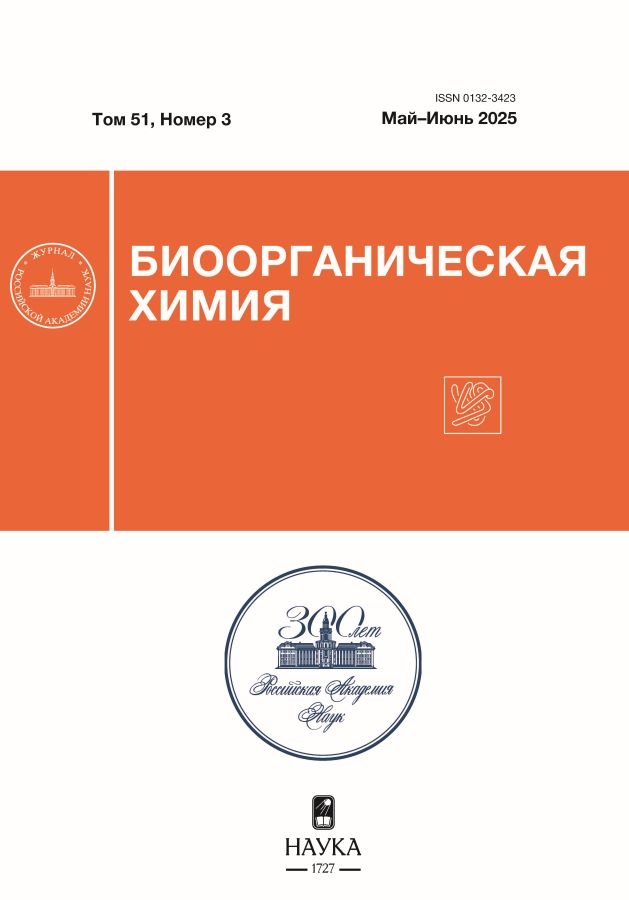Fluorescence labeling of GC-rich DNA matrix with different nucleotide derivatives for hybridization analysis on a biological microarray
- Авторлар: Barinova I.O.1, Shershov V.E.1, Varachev V.O.1, Surzhikov S.A.1, Grechishnikova I.V.1, Zasedateleva О.A.1, Nasedkina T.V.1, Chudinov А.V.1
-
Мекемелер:
- Engelhardt Institute of Molecular Biology, Russian Academy of Sciences
- Шығарылым: Том 51, № 3 (2025)
- Беттер: 538-544
- Бөлім: ПИСЬМА РЕДАКТОРУ
- URL: https://vietnamjournal.ru/0132-3423/article/view/687056
- DOI: https://doi.org/10.31857/S0132342325030165
- EDN: https://elibrary.ru/KRYKBO
- ID: 687056
Дәйексөз келтіру
Аннотация
We investigated the efficiency of labeling the GC-rich promoter region of the TERT gene in the human genome with derivatives of 5′-triphosphates of 2′-deoxyuridine (dU) and 2'-deoxycytidine (dC) containing cyanine dyes Cy5 and Cy7 as a fluorescent label. The effect of modified nucleotides on the efficiency of the polymerase chain reaction was evaluated by real-time PCR, and the extent of nucleotide incorporation into the PCR product was also determined. The efficiency of DNA matrix labeling was determined by the intensity of fluorescent signal during allele-specific hybridization on a biological microarray. The highest level of biochip cell fluorescence was observed for dU-Cy7 derivatives compared to dU- and dC-Cy5 derivatives. At the same time, in the case of GC-rich DNA matrix, the use of dC-Cy5 derivatives gave a fundamentally better result compared to dU-Cy5 derivative. Thus, modified Cy7 analogs capable of incorporation into DNA during PCR are less dependent on the GC composition of the DNA matrix and are more universal fluorescent labels for diagnostic purposes. Further application of modified Cy7 analogs in the development of laboratory-on-a-chip test systems seems to be the most promising.
Негізгі сөздер
Толық мәтін
Авторлар туралы
I. Barinova
Engelhardt Institute of Molecular Biology, Russian Academy of Sciences
Email: tanased06@rambler.ru
Ресей, ul. Vavilova 32, Moscow, 119991
V. Shershov
Engelhardt Institute of Molecular Biology, Russian Academy of Sciences
Email: tanased06@rambler.ru
Ресей, ul. Vavilova 32, Moscow, 119991
V. Varachev
Engelhardt Institute of Molecular Biology, Russian Academy of Sciences
Email: tanased06@rambler.ru
Ресей, ul. Vavilova 32, Moscow, 119991
S. Surzhikov
Engelhardt Institute of Molecular Biology, Russian Academy of Sciences
Email: tanased06@rambler.ru
Ресей, ul. Vavilova 32, Moscow, 119991
I. Grechishnikova
Engelhardt Institute of Molecular Biology, Russian Academy of Sciences
Email: tanased06@rambler.ru
Ресей, ul. Vavilova 32, Moscow, 119991
О. Zasedateleva
Engelhardt Institute of Molecular Biology, Russian Academy of Sciences
Email: tanased06@rambler.ru
Ресей, ul. Vavilova 32, Moscow, 119991
T. Nasedkina
Engelhardt Institute of Molecular Biology, Russian Academy of Sciences
Хат алмасуға жауапты Автор.
Email: tanased06@rambler.ru
Ресей, ul. Vavilova 32, Moscow, 119991
А. Chudinov
Engelhardt Institute of Molecular Biology, Russian Academy of Sciences
Email: tanased06@rambler.ru
Ресей, ul. Vavilova 32, Moscow, 119991
Әдебиет тізімі
- Stumpf A., Brandstetter T., Hübner J., Rühe J. // PLoS One. 2019. V. 14. P. e0225525. https://doi.org/10.1371/journal.pone.0225525
- Dullaert-de Boer M., Akkerman O.W., Vermeer M., Hess D.L.J., Kerstjens H.A.M., Anthony R.M., van der Werf T.S., van Soolingen D., van der Zanden A.G.M. // PLoS One. 2018. V. 13. P. e0190847. https://doi.org/10.1371/journal.pone.0190847
- Ikonnikova A.Y., Filippova M.A., Surzhikov S.A., Pozhitnova V.O., Kazakov R.E., Lisitsa T.S., Belkov S.A., Nasedkina T.V. // Drug Metab. Pers. Ther. 2020. V. 36. P. 33–40. https://doi.org/10.1515/dmpt-2020-0155
- Leevy W.M., Gammon S.T., Johnson J.R., Lampkins A.J., Jiang H., Marquez M., Piwnica-Worms D., Suckow M.A., Smith B.D. // Bioconj. Chem. 2008. V. 19. P. 686–692. https://doi.org/10.1021/bc700376v
- Шершов В.Е., Иконникова А.Ю., Василисков В.А., Лапа С.А., Мифтахов Р.А., Кузнецова В.Е., Чудинов А.В., Наседкина Т.В. // Биофизика. 2020. Т. 65. С. 865–871. https://doi.org/10.31857/S0006302920050038
- Фесенко Д.О., Гусейнов Т.О., Лапа С.А., Кузнецова В.Е., Шершов В.Е., Спицын М.А., Наседкина Т.В., Заседателев А.С., Чудинов А.В. // Мол. биология. 2018. Т. 52. С. 533–542. https://doi.org/10.7868/S0026898418030175
- Иконникова А.Ю., Шершов В.Е., Мороз Ю.В., Василисков В.А., Лапа С.А., Мифтахов Р.А., Кузнецова В.Е., Чудинов А.В., Наседкина Т.В. // Биофизика. 2021. Т. 66. С. 31–39. https://doi.org/10.31857/S000630292101004X
- Bell R.J., Rube H.T., Xavier-Magalhães A., Costa B.M., Mancini A., Song J.S., Costello J.F. // Mol. Cancer Res. 2016. V. 14. P. 315–323. https://doi.org/10.1158/1541-7786.MCR-16-0003
- Фесенко Д.О., Абрамов И.С., Шершов В.Е., Кузнецова В.Е., Суржиков С.А., Гречишникова И.В., Барский В.Е., Чудинов А.В., Наседкина Т.В. // Мол. биология. 2018. Т. 52. С. 997–1005. https://doi.org/10.1134/S0026898418060071
- Lapa S.A., Volkova O.S., Spitsyn M.A., Shershov V.E., Kuznetsova V.E., Guseinov T.O., Zasedatelev A.S., Chudinov A.V. // Russ. J. Bioorg. Chem. 2019. V. 45. P. 263–272. https://doi.org/10.1134/S1068162019040046
- Иконникова А.Ю., Лисица Т.С., Шершов В.Е., Спицын М.А., Гусейнов Т.О., Фесенко Д.О., Лапа С.А., Кузнецова В.Е., Заседателев А.С., Чудинов А.В., Наседкина Т.В. // Биофизика. 2017. Т. 62. С. 1093–1098.
- Boyer A.E., Lipowska M., Zen J.-M., Patonay G. // Anal. Lett. 1992. V. 25. P. 415–428. https://doi.org/10.1080/00032719208016105
- Varachev V.O., Guskov D.A., Shekhtman A.P., Rogozhin D.V., Polyakov S.A., Zacedatelev A.S., Chudinov A.V., Nasedkina T.V. // Russ. J. Bioorg. Chem. 2023. V. 49. P. 1137–1142. https://doi.org/10.1134/S1068162023050205
- Varachev V., Shekhtman A., Guskov D., Rogozhin D., Zasedatelev A., Nasedkina T. // Diagnostics (Basel). 2024. V. 14. P. 200. https://doi.org/10.3390/diagnostics14020200
Қосымша файлдар












